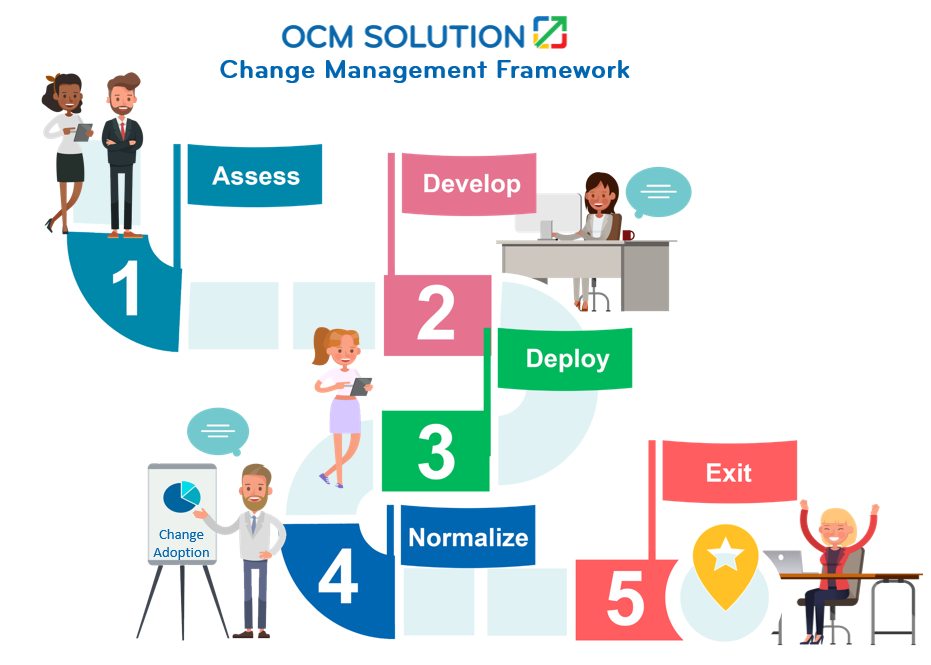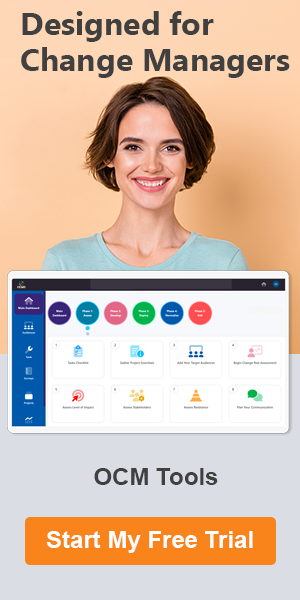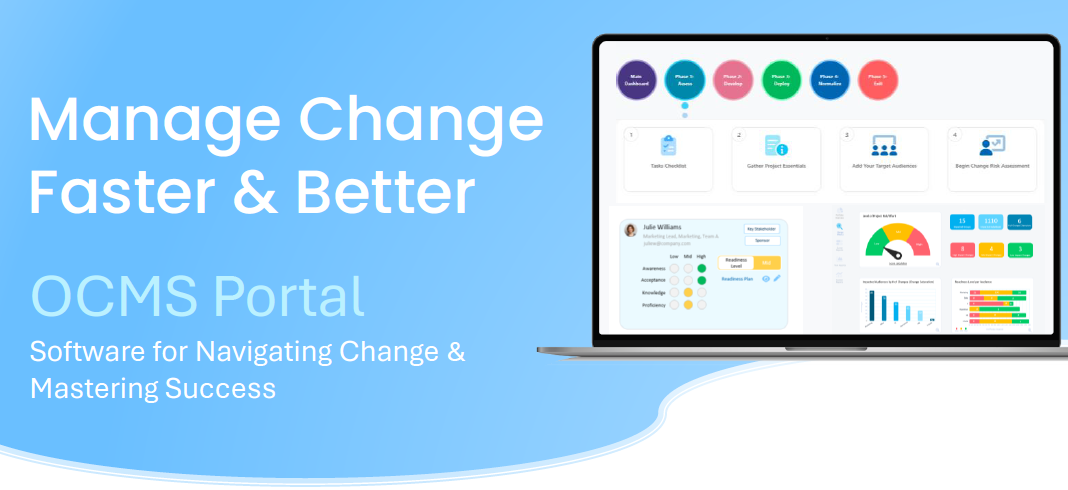Turning Resistance into Results: Proven Strategies for Healthcare Change Management
In healthcare, change is always on the horizon—thanks to new tech, evolving regulations, and the growing needs of patients. But let’s face it, resistance to change in healthcare organizations can throw a wrench into even the best-laid plans for transformation. That’s where effective change management steps in.
It’s up to healthcare leaders and change management pros to navigate the choppy waters of resistance smoothly and get the results they aim for.

OCM Solution is here to help with seven powerful strategies for managing resistance to change in healthcare settings. Read on to gain insights into the best practices and models that can help in facilitating change in healthcare organizations to make your transitions successful.
Key Takeaways
|
The Importance of Change Management in Healthcare
Healthcare organizations operate in a dynamic environment where improvements in patient care, technology, and regulations often require system-wide changes. Implementing change, however, can be challenging due to the complexity of healthcare systems and the deeply ingrained practices of healthcare workers.
Change management in healthcare is a structured approach to transitioning individuals, teams, and organizations from a current state to a desired future state. Without effective change management strategies in healthcare, the implementation of new processes, systems, or structures can face significant roadblocks, such as employee resistance, communication breakdowns, and cultural inertia.
Are you leading or responsible for a mid-to-large project implementation? We can help. Learn more about how Airiodion Group can help you and your organization: Top Rated Change Management Consultants.
Learn more about how Airiodion Group can help you and your organization: Top Rated Change Management Consultants.
Best Healthcare Organizational Change Strategies to Overcome Change Resistance
Before diving into any change management theories in healthcare, it’s important to acknowledge that resistance to change is natural and expected. People get comfortable with their current ways of doing things, tools, and systems. Changing those does not generally come without some type of staff resistance to change in healthcare, no matter whether it’s a small office or large hospital setting.
Whichever change management models in healthcare you may be using, all will include anticipating and overcoming resistance to change in healthcare workplaces. A mix of both proactive and reactive resistance management is key to navigating staff pushback successfully.
In the next sections, we’ll cover the seven strategies designed to overcome resistance roadblocks when implementing change in healthcare organizations.
Please let us know if you have any questions or feedback about the topics of healthcare workers resistance to change, change management theories in healthcare, or change management strategies in healthcare.
1. Understand the Root Causes of Resistance to Change in Healthcare Organizations
The first step to managing resistance during organisational change in healthcare is understanding why healthcare workers resist change. The resistance to change healthcare workers feel can stem from several factors:
- Fear of the unknown: Healthcare professionals may fear that new systems or protocols could disrupt their workflow or threaten their job security.
- Lack of involvement: Staff who feel excluded from the change process are more likely to resist the change.
- Cultural barriers: Healthcare organizations often have long-standing cultures that are resistant to outside influences or new ways of thinking.
- Communication issues: Ineffective communication of the change vision can lead to misunderstandings, misconceptions, and resistance.
Address these root causes of healthcare workers’ resistance to change through open dialogue, involvement in the planning process, and transparent communication. These strategies to implement change in healthcare can go a long way in mitigating resistance.
2. Apply Proven Change Management Models in Healthcare
Using established change management models in healthcare can provide a structured approach to managing change and overcoming resistance. Three widely used change management models are Kotter’s 8-Step Change Model, Prosci’s ADKAR® Model, and OCM Solution’s Change Management Model.
Kotter’s Change Model in Healthcare
John Kotter’s 8-step organizational change model in healthcare offers a framework for managing change in healthcare settings and overcoming resistance:
- Establish urgency by clearly communicating the need for change.
- Build a guiding coalition of influential stakeholders who support the change.
- Create a vision for change to inspire staff.
- Mobilizing Volunteers to help drive the change.
- Empower action by removing obstacles.
- Generate short-term wins to maintain momentum.
- Consolidate gains to keep pushing forward.
- Anchor the change in the organization’s culture to make it stick.
Kotter’s change model in healthcare can be particularly effective when dealing with large-scale transformations, such as adopting new healthcare technologies or overhauling patient care models.
ADKAR Change Management Model in Healthcare
The ADKAR model in healthcare is a goal-oriented framework that focuses on individual change. It consists of five stages:
- Awareness: Ensuring staff understand the need for change.
- Desire: Cultivating a desire to participate in and support the change.
- Knowledge: Providing the necessary training and information to execute the change.
- Ability: Ensuring that staff have the resources and tools to implement the change successfully.
- Reinforcement: Sustaining the change through recognition and feedback mechanisms.
The ADKAR model in healthcare helps leaders manage resistance by addressing individual concerns and ensuring that staff are prepared and supported at every stage of the change process. This is one of the most popular organizational change models in healthcare.
OCM Solution Change Management Model in Healthcare
OCM Solution (OCMS) offers a flexible and deliverables-oriented organizational change model in healthcare. It emphasizes assessment, engagement, resistance management, and metrics tracking. It includes five phases:
- Assess: Conduct interviews and surveys to assess the impact of the change.
- Develop: Use your assessments to develop a change management plan.
- Deploy: Deploy communications, training, and other change management engagement to facilitate the change.
- Normalize: Ensure staff has adequate post-go-live support to sustain the change.
- Exit: Hand off training resources and review a final report for lessons learned.
OCM Solution is one of the organizational change models in healthcare that can easily be used for any type of project. The flexibility and step-by-step layout of tasks and deliverables make it a favored model for managing change in healthcare. Plus, it’s one of the few that includes its own cloud-based change management tools in healthcare, making it easy for change managers to automate their work.
Do you have any questions about Kotter’s change model in healthcare, the ADKAR model in healthcare, or any other change management models in healthcare? Please reach out and let us know!
3. Involve Healthcare Workers Early in the Change Process
One of the most effective change management strategies in healthcare is involving employees early in the change process. Healthcare professionals are often experts in their fields and have invaluable insights into what might work (or not work) in a clinical setting. Staff resistance to change in healthcare can often be mitigated by involving these employees in decision-making, allowing them to voice their concerns, and co-designing solutions that meet their needs for certain aspects of change management in healthcare.
Incorporating feedback from healthcare professionals ensures that the change management process in healthcare is collaborative rather than imposed. This participatory approach fosters a sense of ownership among staff, which reduces resistance and increases engagement.
4. Communicate Clearly and Frequently
Effective communication is critical when implementing change in healthcare organizations. A common reason for the resistance to change healthcare staff feel is poor communication, which leads to confusion, fear, and uncertainty.
Teams for leadership and change management in healthcare should communicate:
- Why the change is necessary: Help staff understand the reasoning behind the change, such as improving patient outcomes or complying with new regulations. As well as the importance of change management in healthcare.
- What the change entails: Provide clear explanations of what the change will involve and how it will impact daily operations.
- How the change will benefit staff and patients: Emphasize the positive outcomes, such as reducing administrative burdens or enhancing patient care.
Regular updates and transparency help foster trust during change management in hospitals and healthcare facilities and keep employees informed, which in turn reduces uncertainty and resistance.
5. Provide Comprehensive Training and Support
A lack of training and support is a major factor in resistance to change during organizational change management in healthcare. Healthcare professionals may feel overwhelmed or unprepared to adopt new technologies or processes, leading to pushback. Ensuring that staff are adequately trained is essential to the success of healthcare organizational change.
Invest in comprehensive training programs tailored to different staff roles as part of your change management principles in healthcare. Additionally, provide ongoing support after the new solution rolls out, such as mentorship or troubleshooting resources, to help healthcare workers overcome challenges they encounter while implementing the change. Some change management in healthcare examples of post-go-live support include providing an FAQ, holding office hours to provide support, and offering additional training as needed.
Please let us know if you have any good strategies for implementing change in healthcare or organizational change models in healthcare you’d like us to add to this article.
6. Demonstrate Strong Leadership and Change Champions
Leadership and change management in healthcare play a pivotal role in overcoming resistance. Change leaders must model the behaviors they want to see, demonstrating a commitment to the change and addressing staff concerns proactively.
In addition to strong leadership, designating change champions within the organization can help foster support. Change champions are influential staff members who advocate for the change and encourage their peers to embrace it. These champions are key to overcoming resistance to change in healthcare as they bridge the gap between leadership and frontline workers.
7. Leverage Change Management Tools in Healthcare
To successfully manage resistance and streamline the change process, healthcare leaders can benefit from using specialized change management tools in healthcare. These tools help organize, track, and communicate progress, ensuring that all aspects of the change process are managed effectively.
Some effective tools include:
- Change management software to track tasks, perform assessments, send surveys, and provide risk analysis.
- Employee feedback platforms to gather real-time insights from staff.
- Training management systems to ensure all staff are properly trained.
- Data analytics tools to measure the effectiveness of the change.
Incorporating the right tools can help simplify the organisational change in healthcare process, track progress, and ensure that any issues are addressed before they become major obstacles.
Do you have any questions about how to manage healthcare organizational change, change management principles in healthcare, or implementing change management in hospitals? Just let us know!
Examples of Change Management in Healthcare
Example 1: Implementation of Electronic Health Records (EHR) Systems
One of the prominent change management in healthcare examples is the implementation of EHR systems. Many hospitals face initial resistance to this change due to concerns about learning new software and disrupting established workflows.
By applying a process and change management theories in healthcare that include early involvement of healthcare professionals, comprehensive training, and continuous support, many organizations can successfully implement EHR systems and improve patient care delivery.
Example 2: Adoption of Telemedicine
The rapid adoption of telemedicine during the COVID-19 pandemic is another instance of healthcare change management. Resistance to this change initially stems from concerns about the quality of care delivered remotely and a lack of familiarity with telemedicine platforms.
By applying Kotter’s change model in healthcare, hospitals can build urgency around the need for telemedicine, provide the necessary resources, and reinforce the benefits for both patients and providers.
For a step-by-step of the actual change management in hospitals process, using the OCM Solution model can guide change practitioners on the actions to carry out and provide the matching software that backs up these change management principles in healthcare.
Are you leading or responsible for a mid-to-large project implementation? We can help. Learn more about how Airiodion Group can help you and your organization: Top Rated Change Management Consultants.
Learn more about how Airiodion Group can help you and your organization: Top Rated Change Management Consultants.
Please let us know if you have any questions or feedback about these change management in healthcare examples, managing resistance for organisational change in healthcare, or the ADKAR change management model in healthcare.
Conclusion: Overcoming Resistance to Change in Healthcare
Resistance to change in healthcare organizations is a natural and expected response, especially in an industry where lives are at stake and established practices are deeply ingrained. However, by applying effective change management strategies in healthcare, involving employees in the process, and using proven models and change management theories in healthcare, leaders can overcome resistance and successfully implement organizational change.
Good strategies for implementing change in healthcare are not just about introducing new technologies or processes; they’re about managing the people side of change. By prioritizing communication, training, and leadership, healthcare organizations can navigate the complexities of change and improve outcomes for both staff and patients.
An effective change management process in healthcare is essential for the smooth and successful adoption of new initiatives, technologies, and processes. By understanding and addressing the root causes of resistance to change in healthcare, change practitioners and project leaders can reduce pushback and foster a positive and successful transition.
Any last questions about organizational change management in healthcare, using change management principles in healthcare, or leadership and change management in healthcare? Please reach out and let us know.
What’s the Best Software for Managing Healthcare Organizational Change?
The importance of change management in healthcare requires change practitioners to use the right tools for assessing, managing, and tracking the success of changes. OCMS Portal is a leading change management platform used by Fortune 100 and 500 companies.
It provides tools, tasks, and guidance to manage all aspects of change management in healthcare. Enjoy time-saving features such as built-in assessment surveys, automated OCM plans, real-time analytics, and much more!
Sign up for a free no-risk trial today for software to help with managing resistance to change in healthcare.
FAQ: Change Management Theories in Healthcare
What are some popular change management models in healthcare?
Using one of the change management models in healthcare helps to reduce change roadblocks and ensure a successful transition. Some of the popular change management theories in healthcare include:
- Kotter's change model in healthcare
- Prosci’s ADKAR change management model in healthcare
- OCM Solution’s change management model
What strategies can be used to overcome resistance to change in healthcare?
Some strategies for implementing change in healthcare organizations and mitigating resistance are to understand the root causes of resistance, include staff early in the change process, communicate often, and provide adequate training and support both before and after the changes are implemented.
What are some examples of change management in healthcare?
A couple of change management in healthcare examples include introducing a new EHR system and involving staff in the process of testing, selection, and training to help them feel they’ve had some agency in the process.
Another example of facilitating change in healthcare is the introduction of telehealth. One of the important strategies to implement change in healthcare successfully is to communicate the benefits of the new system in a way that speaks to the daily experience of staff and their patients.
Do you need change management consulting support or help?
Contact Airiodion Group, a specialist change management consultancy that supports organizations, project managers, program leads, transformation leaders, CIOs, COOs, and more, who are navigating complex transformation initiatives. For general questions, contact the OCM Solution team. All content on ocmsolution.com is protected by copyright.
External Sources: stock.adobe.com






